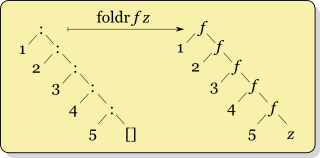http://yi-programmer.com/2011-02-24_fold.html
http://c2.com/cgi/wiki?FoldFunction
http://rwh.readthedocs.org/en/latest/chp/4.html
The PythonLanguage calls it reduce; this is a left fold:
reduce(operator.add, [1,2,3,4]) reduce(lambda x,y: x+y, [1,2,3,4])
You can get the effect of the parameter called initial above by giving an optional third argument.
In Python 3.x it has been moved to "functools.reduce".
python foldl和foldr实现:
def foldl(f,z,xs): if not xs: return z else: return foldl(f,f(z,xs[0]),xs[1:]) def foldr(f,z,xs): if not xs: return z else: return f(xs[0],foldr(f,z,xs[1:])) a=[1,2,3,4,5] import operator print foldl(operator.add,1,a) print foldr(operator.add,1,a)
foldl:
(((((init+1)+2)+3)+4)+5)
folr:
(1+(2+(3+(4+(5+init))))))
在函数式语言中,列表这个结构是通过空列表 nil 和操作符 cons 进行定义的,haskell中对应有 [] 和 (:) 的语法糖。所以[1,2,3,4,5] 实际上是 1:[2:[3:[4:[5:[]]]]] ,这样一来,我们可以从一个新的视角看待 fold 操作, foldr (+) [] 操作其实就是将操作符 (:) 替换为 (+) :


参考了:http://stackoverflow.com/questions/9204209/tutorial-for-summation-recursion-in-python